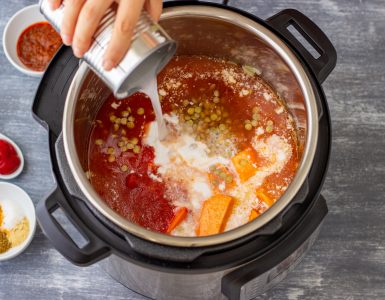When you’re first getting into sous vide cooking, Ziploc bags are a common choice. In fact, they’re our top recommendation for beginners, because they’re affordable and easy to find (and you may even have them in your kitchen already). As you get more serious, you may find that you want to use vacuum bags instead, but Ziplocs are a great starting point!
Read on to learn all about how to use Ziploc bags for sous vide. We’ll cover their safety, some best practices, how to seal them, and alternatives you can use instead if you prefer.
Table of Contents
Are Ziploc Bags Safe for Sous Vide?
This is one of those tough questions that’s a matter of opinion in some ways. If you’re concerned about warm or hot plastic being in direct contact with your food for several hours at a time, you may prefer to avoid this technique altogether.
However, we believe that Ziploc bags are safe. CNET explains that “High-density polyethylene, low-density polyethylene and polypropylene are the safest plastics to cook with.”
Ziploc bags are, fortunately, made from polypropylene—one of CNET’s recommendations for the safest plastics. Most vacuum sealer bags are made from polyethylene, another of the recommended options.
In short, you’ll need to make up your own mind about your opinion on plastics, but we don’t see any cause for concern with Ziploc bags (and in fact use them ourselves frequently).
Are Ziploc Bags BPA Free?
Yes! Ziploc bags are both BPA-free and dioxin-free. Since these are the two substances that most people tend to be concerned about in their plastics, the absence of both is reassuring.
Be aware that we’re talking specifically about true Ziploc-brand bags, not necessarily all resealable plastic bags made in the same style. If you can’t find Ziploc-brand bags near you, do some research to make sure your locally available brand is BPA-free.
How Do You Sous Vide With Ziploc Bags?
There’s no need for fancy vacuum sealers! (And in fact they don’t work with this kind of bag anyway, and require special vacuum sealer bags.)
Instead, you can simply put your food into a Ziploc bag, and then remove most of the air using the water displacement method.
From there, proceed with the recipe as normal. You don’t need to adjust your cooking times or temperatures for a Ziploc bag as opposed to a vacuum-sealed bag. The only real difference is that you need to be a little more careful to make sure the bags don’t float, since the water displacement method doesn’t remove quite as much air as a vacuum sealer would.
Do You Need to Double-Bag?
We’ve tested Ziploc bags for sous vide extensively and have very, very rarely had any issues with leakage. In fact, these issues are so rare that we ourselves don’t generally double-bag when we use them, because they’ve proven themselves to be consistently trustworthy.
With that said, you may want to use two bags if you’re particularly concerned about a specific meal. Maybe you’re cooking with some really high-end ingredients, or desperately want to impress a certain someone. In these sorts of situations, we recommend double-bagging simply for your own peace of mind.
To double-bag, use the water displacement method as normal, with just one bag. Then place that air-free sealed bag into a second bag, and repeat the water displacement method. This ensures that even if one of your bags leaks, the other keeps the food safe and dry.
Reusing Ziploc Bags for Sous Vide
Whether your concern is for the environment or your wallet (or both!), the possibility of reusing Ziploc bags comes up pretty frequently. Our rule of thumb is to avoid reusing bags that were potentially contaminated with raw meat, even if you then cooked them in a sous vide bath afterward. (This choice is backed up by the advice from The Takeout, which recommends not reusing bags that have been used for raw meat, fish, or eggs).
The Takeout also points out that you should be cautious about potential allergens if that’s an issue with the people you’re serving. Don’t reuse a bag that contained nuts if you’re going to serve food to someone with a nut allergy, even if you’ve washed it thoroughly!
Finally, don’t reuse damaged or leaky bags. This should go without saying, but it’s worth clarifying just in case.
Other than these cases, yes, you can reuse your Ziploc bags for sous vide! Simply wash them thoroughly with dish soap, rinse clean, and then hang until completely dry. They’re then ready to use again!
We recommend only reusing a bag once (for two uses total) for sous vide. If it’s still intact after that, you can wash it and reuse it for other things like food storage. However, we personally choose not to risk leaks by reusing a bag at prolonged elevated temperatures too many times.
What Can I Use Instead of Ziploc Bags for Sous Vide?
Biodegradable plastic bags (not yet clear whether they’ll work):
We’ve reached out to several companies that make biodegradable resealable bags to discuss whether they’re appropriate for sous vide. Of course it would be preferable to avoid plastic waste, and we’d love to be able to use biodegradable bags instead of plastic Ziplocs!
Unfortunately, at the time of publication, we have not yet received any response. We’ll update this post when we know more.
Vacuum sealer bags (most practical choice for most uses):
For the average home cook, vacuum sealer bags are the most practical alternative to Ziploc bags for most uses. They tend to have fewer leakage issues (although Ziploc bags are surprisingly reliable, in our experience), and a good vacuum sealer should be able to get out more air than the water displacement method.
Of course, using vacuum sealer bags doesn’t eliminate the plastic waste issue. They’re also not a great choice for anything too wet, like foods with sauces or marinades. (For that, you’d need a chamber vacuum sealer instead.)
Glass jars (acceptable for certain tasks):
Depending on what you’re making, you might be able to use a canning jar instead of a Ziploc bag for your sous vide food.
First things first: jars are not the right choice for most meat-based preparations. Don’t try to fold up a steak and stuff it into a jar! (One notable exception is confit preparations, which we’ll explain in more detail in a moment.)
For anything you want to cook in a jar, you’ll need a lot of liquid.
Sometimes this means that the food itself is liquid or liquid-based (think of yogurt, creme brulee, or infused vodka).
Sometimes it means that the food you’re cooking is surrounded by liquid. Confit is a great example of this; you completely surround solid food (most often poultry) with fat and slow-cook it. Another example might be poached peach slices in syrup. In both of these cases and anything similar, the food you’re cooking needs to be completely submerged in the cooking liquid.
Conclusion
Ziploc bags don’t contain BPA or dioxin, minimizing the health concerns about using them for sous vide. And, in most cases, they’re all you need! (In fact, we use them often despite having other options.) Just be aware that Ziploc bags can (rarely) leak, so a vacuum sealer may be a better choice if you have one. This is particularly true for extended cook times of more than 4 hours, or if you’re cooking at relatively high temperatures.
Depending on what you’re cooking, you might be able to use a resealable glass jar (like a canning jar). Glass jars work best for liquids or liquid-surrounded foods, though, so don’t plan on cooking a steak in a jar. For now, it’s not clear whether biodegradable resealable plastic bags are a viable alternative to Ziploc bags for sous vide, but we’ll keep you posted when we get answers from the companies that make them.










